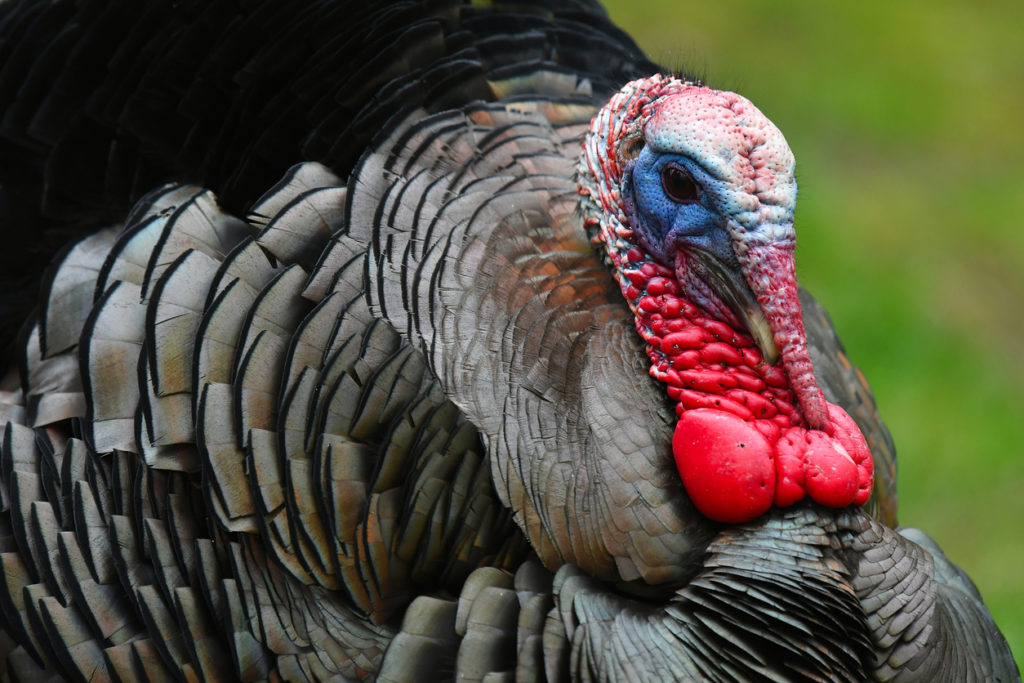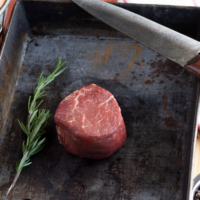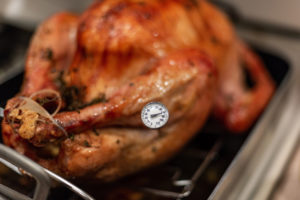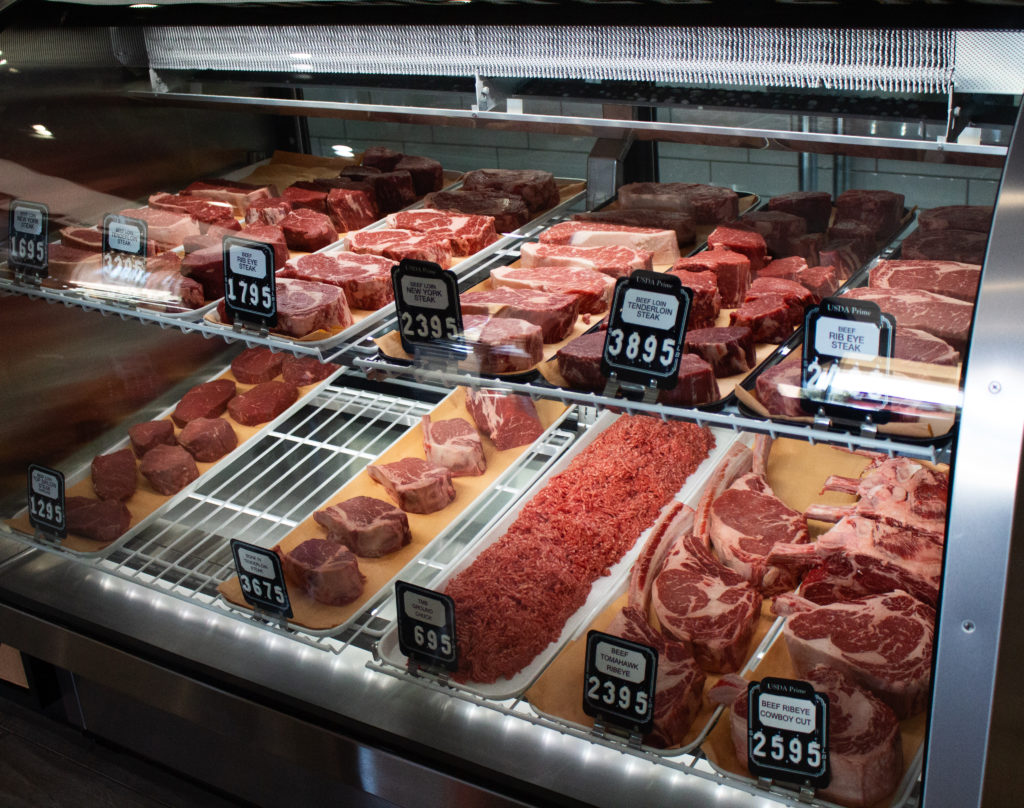Pass (on) the Turkey
Editor’s Note: The temperatures given in the print version of this article for the strip loin and the turkey are incorrect. Please note the correct temperatures below:
Strip loin – 135 °
Turkey – The USDA says that a turkey should be cooked until “the innermost part of the thigh and wing and the thickest part of the breast” reach 165°. Joe Riscky suggests removing the turkey a little before the temperature reaches 165° as carryover cooking will continue after the bird is removed from the oven.
I, as Editor of Madeworthy, apologize for the misinformation.
– Lee

Americans gobble around 45 million turkeys a year. Whether the bird is roasted, smoked, or fried, turkey meat requires extensive prep work and an attentive eye to keep the juices in and the meat tender. But even an award-winning effort may not elevate the morsels to the culinary experience of, say, rack of lamb or prime rib.
Pit master Joe Riscky, who heads operations at The Meat Board – the newish Ridglea Hills butcher shop and lunch spot owned by cattle rancher Don Rea and food microbiologist Ranzell Nickelson – offered tips for Thanksgiving-friendly turkey alternatives. Tenderloin topped his list.

Photo courtesy of The Meat Board
“Tenderloins are rich and seasonal,” he said. “It reminds me of the holidays. We used to eat a lot of tenderloin growing up.”
Whether you buy your tenderloin at The Meat Board (my recommendation) or elsewhere, the first step is to “barrel it out” or trim it into the classic cylindrical tenderloin shape. Riscky recommends a special cut of meat called chateaubriand. Any experienced butcher will know how to prepare the chateaubriand for cooking.
Riscky suggests that you make a rub that’s heavy on salt and pepper with lesser amounts of garlic, chile, and paprika and spread liberally over the tenderloin. Smoke the meat over oak for an hour to an hour-and-a-half or until the center of the meat reaches 120° to 130°. Then serve hot or cold.
A strip loin is another great holiday option, Riscky said. The tender cut of beef can be roasted in the oven or smoked until the center of the meat reaches 135°. Mild post oak or pecan wood work best for smoking, according to the pit master. “Smoke it for about an hour or two hours,” he said. “Then it will be medium rare going toward medium. It’s pretty much like prime rib. Cut it into inch-and-a-quarter slices and [sear them in] a hot skillet. Then it’s a smoked steak.”
 Ham and briskets are great holiday options too, he added. If turkey is a must-have, Riscky recommends cooking the bird until it’s 150° at its core. While safety guidelines often recommend internal temperatures of 165°, cutting the heat before that threshold spares the meat from drying out, he said. [Please see note at the beginning of this article.]
Ham and briskets are great holiday options too, he added. If turkey is a must-have, Riscky recommends cooking the bird until it’s 150° at its core. While safety guidelines often recommend internal temperatures of 165°, cutting the heat before that threshold spares the meat from drying out, he said. [Please see note at the beginning of this article.]
Rubs for turkey should be kept simple: salt, pepper, and a little garlic. Riscky recommends adding brown sugar to any rub to get a nice, caramelized glaze. For many cooks (and diners), turkey breasts are preferable to whole turkeys. “You aren’t worried about bones or what to do with the gizzard,” he said. “[The breast has] a 100% yield, and it’s the best part of the turkey.”
If reading about smoked meats has you pining for luxurious ribeye steaks and meaty ribs, the “meat geeks” at The Meat Board are ready to help you elevate your cooking game ahead of the holidays. It was clear from my visit that they live to encourage and inform folks about grilling, no matter what skill level a visitor has. Nearby Board Room hosts small groups for cooking lessons or meetings.
With few exceptions, the meaty offerings at the butcher shop are wet aged for 30 days before being sold. The aging creates a transcendent meat-eating experience that blends buttery textures with complex flavor profiles. Riscky and fellow employee Dylan Tucker said meat scientists have done the hard work of testing the shear force (measured in newtons) required to slice (and presumably chew) various cuts of pork, poultry, and beef at different stages of wet-aging. While it’s wonderful that meat scientists are so diligent, most of us are more interested in taste and texture, and The Meat Board’s wet aging process ensures a delicious experience.

Photo courtesy of The Meat Board
Whatever your choice, work with a meat that has a special history with your family for the holidays and cook your choice with care, Riscky said. The pit master said his Thanksgivings are spent at his family’s farm west of town.
“My aunt does the traditional Thanksgiving dinner,” he said. “I usually take the day off because I’m beat. The day after, Friday, is the big day… we will have a pit out there, and we will smoke some stuff. We do a traditional turkey. My uncle loves to deep-fry them.
Riscky said he also enjoys a good turkey sandwich. As far as chowing down on an entire turkey, he saves one special day a year to gobble America’s favorite holiday bird.
“I don’t mind a whole turkey, but I like it on Thanksgiving,” he said. “And once a year is fine.”
 Edward Brown is a writing tutor and piano teacher. He is also an award-winning writer for the Fort Worth Weekly and volunteers for numerous Fort Worth nonprofits. He has spent the last two weeks walking and talking with the protesters in Fort Worth.
Edward Brown is a writing tutor and piano teacher. He is also an award-winning writer for the Fort Worth Weekly and volunteers for numerous Fort Worth nonprofits. He has spent the last two weeks walking and talking with the protesters in Fort Worth.


 Sign in
Sign in

